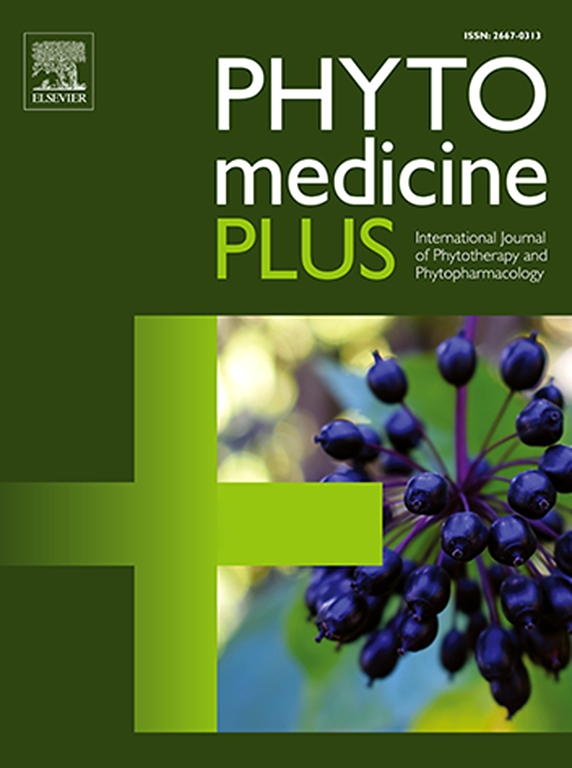Exploring the antimicrobial and antioxidative potential of Leucas aspera (Willd.) link: Phytochemical screening, molecular docking, and HR-LC/MS profiling against SARS-CoV-2 protein 3CLPro, Spike and RDB
Q3 Pharmacology, Toxicology and Pharmaceutics
引用次数: 0
Abstract
Background
Leucas aspera (Willd.) Link, a member of the Lamiaceae family and commonly known as "Thumbai," is found throughout India and has been utilized in traditional Indian medicine to treat various ailments.
Purpose
This study entails methanolic extraction of Leucas aspera (Willd.) Link using a Soxhlet apparatus, followed by phytochemical screening and antioxidant activity assessment.
Methods
The L. aspera methanolic leaf extract displayed a phenolic content of 100 µg/ml, consisting of 3.02 mg of gallic acid dry weight equivalents and a flavonoid content of 100 µg/ml with 3.35 mg quercetin equivalents per dry weight. The extract's free radical scavenging capabilities were at 150 µg/ml in DPPH, showing an 87 % effectiveness compared to the standard ascorbic acid 49 % inhibition capacity. The ABTS radical scavenging activity in 100 µg/ml extract measured 64.32 %, phosphomolybdate assay indicated 86.89%, and hydroxide radical scavenging capacity showed 126.72 %. Antibacterial activity was also assessed through agar well diffusion assays against Klebsiella pneumoniae, Salmonella typhi, Staphylococcus aureus, and Leucobacter sp., Where K. pneumoniae exhibits the highest zone of inhibition. The methanolic crude extract of L. aspera was further using TLC, FT-IR and HR-LC/MS to identify functional groups and phytocompound present in the extract.
Results
HRLC-MS was used to conduct metabolite profiling of the methanolic crude extract of L. aspera leaves, discovering 37 positive and 43 negative compounds. To evaluate the ADMET properties and predict the drug-likeness of these 80 phytochemicals, an in silico analysis was performed. The results of this analysis revealed that only 19 of the compounds met the ADMET limitations and had suitable Log P values. Molecular docking of the 19 compounds against the SARS-CoV-2 main protease (3CLPro) protein (PDB ID: 6LU7) and spike protein receptor binding domain (SGp-RBD) protein (PDB ID: 2GHV) revealed Famprofazone and Loxtidine compounds having the highest binding affinity with LibDock scores of 105.53 and 116.70 respectively.
Conclusion
Thus, our findings could serve as potential active molecules of L. aspera against this target protein. This study provides further proof of bioactive compounds produced by the L. aspera leaf extract.

探索白桉(野生)的抗菌和抗氧化潜力链接:植物化学筛选、分子对接和HR-LC/MS分析对SARS-CoV-2蛋白3CLPro、Spike和RDB
背景:lucas aspera(野生)林克是Lamiaceae家族的一员,通常被称为“Thumbai”,在印度各地都有发现,在印度传统医学中被用来治疗各种疾病。目的:采用甲醇提取法提取刺槐(野生)。链接使用索氏装置,其次是植物化学筛选和抗氧化活性评估。方法石竹叶甲醇提取物的酚类含量为100µg/ml,其中没食子酸含量为3.02 mg /干重;类黄酮含量为100µg/ml,槲皮素含量为3.35 mg /干重。在DPPH中,提取物的自由基清除能力为150µg/ml,与标准抗坏血酸49%的抑制能力相比,其效率为87%。100µg/ml提取物的ABTS自由基清除率为64.32%,磷钼酸盐清除率为86.89%,氢氧自由基清除率为126.72%。通过琼脂孔扩散试验对肺炎克雷伯菌、伤寒沙门氏菌、金黄色葡萄球菌和白色杆菌的抑菌活性也进行了评估,其中肺炎克雷伯菌表现出最高的抑制区。进一步采用TLC、FT-IR、HR-LC/MS等方法对粗提物中的官能团和植物化合物进行鉴定。结果采用shrlc - ms对白杨叶甲醇粗提物进行代谢谱分析,发现阳性化合物37个,阴性化合物43个。为了评估ADMET性质并预测这80种植物化学物质的药物相似性,进行了计算机分析。分析结果显示,只有19个化合物符合ADMET限制,具有合适的Log P值。对19个化合物与SARS-CoV-2主蛋白酶(3CLPro)蛋白(PDB ID: 6LU7)和刺突蛋白受体结合域(SGp-RBD)蛋白(PDB ID: 2GHV)的分子对接发现,与LibDock评分最高的是Famprofazone和Loxtidine化合物,分别为105.53和116.70。结论本研究结果可作为葡萄球菌对该靶蛋白的潜在活性分子。本研究进一步证明了曲霉叶提取物产生的生物活性化合物。
本文章由计算机程序翻译,如有差异,请以英文原文为准。
求助全文
约1分钟内获得全文
求助全文
来源期刊

Phytomedicine Plus
Medicine-Complementary and Alternative Medicine
CiteScore
3.70
自引率
0.00%
发文量
178
审稿时长
81 days
期刊介绍:
 求助内容:
求助内容: 应助结果提醒方式:
应助结果提醒方式:


